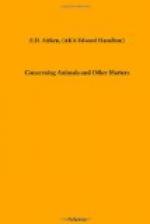Among the classic fairy-tales which passed like shooting stars across those dark hours of our boyhood in which we wrestled with the grim rudiments of Latin and Greek, and which abide in the memory after nearly all that they helped to brighten has passed away, there was one which related to a contest between Neptune and Minerva as to which should confer the greatest benefit on the human race. Neptune first struck his trident on the ground (or was it on the waves? “Eheu fugaces”—no, that also is gone), and there sprang forth a noble steed, pawing the ground, terrible in war and no less useful in peace. Then the watery god leaned back and smiled as if he would say, “Now, beat that.” But the Goddess of Wisdom brought out of the earth a modest, dark tree bearing olives and, in classic phrase, “took the cake,” Oriental mythology is more luxuriant and fantastic than that of the West, but I do not know if it has any legend parallel to this. If it has, then I am sure the palm is awarded to the deity who gave to the human race the tree that bears the coconut.
Passing a confectioner’s shop, I saw a tempting packet labelled “Cokernut Toffee.” I bought a pennyworth and gave it to my little girl, and
“I laye a-thynkynge, a-thynkynge, a-thynkynge.”
How many boys and girls are there in this kingdom to whom the word coconut connotes an ingredient which goes to the making of a very toothsome sweetie? And how many confectioners and shop girls are there whose idea is no broader? Again:
“I laye a-thynkynge, a-thynkynge,
a-thynkynge,
And merrie sang the Birde as she sat upon
the spraye.”
And I said, “Little Bird, what do you know of the coconut?” And it made answer, “It is a cup full of food, rich and sweet, which kind hands hang out for me in winter,” How narrow may be the key-hole through which we take our outlook on things human and divine, never doubting that we see the whole! In our own British Empire, only a few thousand miles away, sits a mild Hindu, almost unclad and wholly unlettered, to whom the tree that bore the fruit that flavoured the toffee that my little girl is enjoying seems to be one of the predominating tints of the whole landscape of life. It puts a roof over his head, it lightens his darkness, it helps to feed his body, it furnishes the wine that maketh glad his heart and the oil that causeth his face to shine, and time would fail me to tell of all the other things that it does for him. As a type and symbol, it is always about him, spanning the sunshine and shower of life with bows of hope.
The coconut tree is a palm, and has nothing to do with cocoa of the breakfast table. That word is a perversion of “cacao,” and came to us from Mexico: the other is the Portuguese word “coco,” which means a nut. It is what Vasco da Gama called the thing when he first saw it, and the word, with our English translation added, has stuck to it. The tree is, I need scarcely




